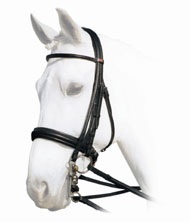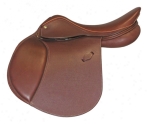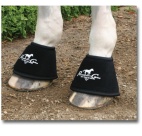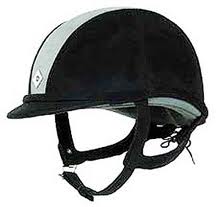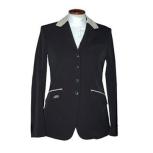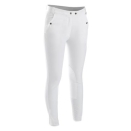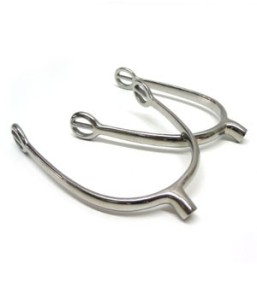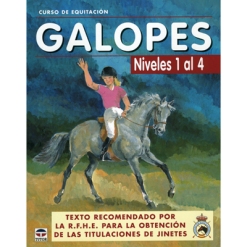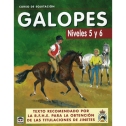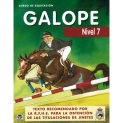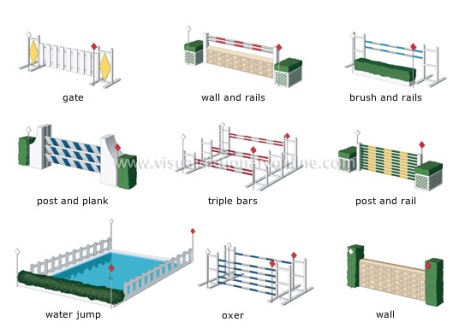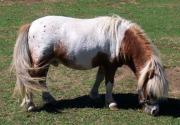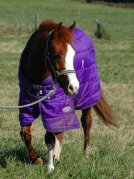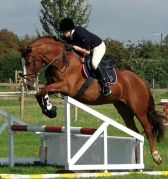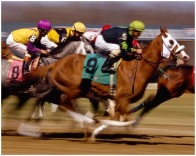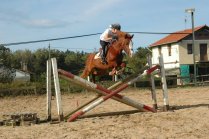This BlogSpot is going to be about my favorite hobby which is horse riding. This hobby or Sport has many different categories/competitions that are these ones : dressage, raid, races, cross country, polo, Horse Show Jumping Competitions….etc. as you can see there are a lot so I will just explain 4 of them and specially the one of “Horse Show Jumping Competions”. The other 3 categories will be cross-country, dressage and races. So, taken this into account this are the points that are developed along this blog:
- The origin of the horses to introduce you to the topic
- Horse and rider equipment
- Horse Show Jumping Copetitions
- What is based on
- When, how and why does this discipline developed until nowadays;
- The rules of the competition;
- Type of obstacles;
- Ponies´competitions
- Horses: The most important events of the show jumping competitions:
- Progressive difficulty event
- The derby event,
- Doubles and triples even
- Dexterity and power contest or events
- Potency events, The sixbars´ dexterity contest
- Other Horse competitions
- Hunting or speed and driven contest: (Cross Country).
- Dressage
- Races
- My own experience and what is my opinion about this competitions
- Abstract
THE ORIGIN OF THE HORSES:
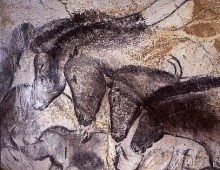 Horses are said to be originally from North America although then they migrate to South America and Asia. Since then, they start arriving to Europe and finally to Africa.
Horses are said to be originally from North America although then they migrate to South America and Asia. Since then, they start arriving to Europe and finally to Africa.
In the Stone Age when hunter tribes arrived to America, horses started being hunting until their extermination. However, at the beginning of XVI century when Spanish conquerors arrive to America horses started being introduced again in the continent. Herman Cortes was the explorer and conqueror who went to Cuba and Mexico bringing there, 16 horses.
Indeed, it is very important to mark that horses have always being very important for humans as they were used as a domesticated animal, because of their strength and speed: they were used as transport both for load and humans; to wars (for example: the Arabian tribes use them to conquest the Middle West and North Africa and also to get in Spain.). This ones indeed grew up one little but resistant horse called “the Arabian horse” which was highly fast and useful to move in the desert; to create an empire (for example: in the XIII century the Mongolians move to Central Asia and thanks to the horses they create an empire);…etc
In addition, horses have also always being part of important legend and stories as for example “Pegaso” which appears in the Greece mythology, or “the Trojan Horse”, a wooden horse built by the Greeks to get in Troja.
Nowadays, horses are not such just for transport, for wars…etc but for sport and those kinds of activities: Dressage, Raid, Cross Country, Show Jumping competitions, Polo…etc. As I have already said at the beginning in this post we are going to focus on “the Horse Show Jumping Competitions”.
BASIC EQUIPMENT (Nowadays) FOR THE 4 CATEGORIES :
Horse and rider equipment:
Horse equipment:
Bridle Saddle
Leg & Hoof Protection
Saddle Pad
Riders´ equipment:
Helmet Back Protector
Jacket Boots
White trousers White shirt
Whip Spurs
HORSE SHOW JUMPING COMPETITIONS
*WHAT IS THE HORSE SHOW JUMPING COMPETITIONS BASED ON?
This discipline is one part of the horse-riding in which the horse and the rider have to jump over different obstacles in one concrete order. This is one of the most famous and practiced Equestrian sport and also one of that in top competitions gives or shares a lot of money, as the same time as horse races competitions which are also vey famous and important inside this sport.
This sport as is composed by two members these ones are also called “binomial” and also “athletes”.
*WHEN, HOW AND WHY DOES THIS DISZIPINE DEVELOPED UNTIL NOWADAYS?
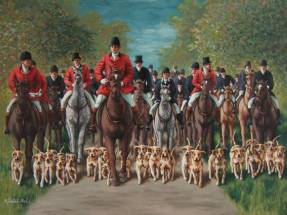 In the second middle of the XVIII century horse jumping became very important skill for hunting and even more important in the XIX century as the hunting activities increased in Great Britain specially but also all over the continent. Since this moment, horses started developing new skills and improve some others such as the speed, the resistance, the capacity to jump different natural obstacles….etc to chase after foxes and other wild animals and hunt them as fast as possible.
In the second middle of the XVIII century horse jumping became very important skill for hunting and even more important in the XIX century as the hunting activities increased in Great Britain specially but also all over the continent. Since this moment, horses started developing new skills and improve some others such as the speed, the resistance, the capacity to jump different natural obstacles….etc to chase after foxes and other wild animals and hunt them as fast as possible.
Due to this kind of activities, horse show jumping competitions start developing although at beginning they had not too much success. This problem was much related to the fact that these competitions were represented or made in wide spaces and so viewers couldn’t see the competitions completely. However, when they realized that the problem was that, they started preparing and making these competitions in smaller spaces. Since this moment these kinds of competitions started being called “Lepping”.
The first “Lepping” was celebrated in 1865 in Ireland in the “Dublin Horse Show”, and 15 years later this kind of horse shows also arrived to England. Indeed, by the year 1900, the most important and famous horse show jumping competitions also arrive to Britain islands.
Some improvements, advancements…etc:
- Grand Prix competition, in Paris in 1866.
- 1900, in Olympic Games, appeared for the first time the horse show jumping competition divided in different categories. (not official until 1906)
- In 1902, Federico Caprilli discovered that “the Suspension riding style” help not to hurt horses back and this way to jump over higher obstacles. In 1902 this man score a record jumping with his horse “Melapo” one obstacle which was about 2,08 meters high.
- In 1921 the International Equestrian Federation was founded and due to this, this discipline became homologated in different international competitions including the equestrian world games and the Olympic Games.
At the beginning and especially before the Second World War most of these famous competition (the Olympic games of Paris in 1900, the ones from Stockholm in 1912, those from Helsinki in 1952 …etc) were exclusively for officials from the armed cavalry of different national armies. Nevertheless, in 1956 in the Olympics games from Melbourne, the amazons/horsewomen first were able to take part in these highly important and famous competitions. Sin this moment this competitions start becoming more available not just for that kind of people but also for ordinary people until reaching nowadays situation.
*THE RULES OF THE COMPETITION:
Depending on the rules you will get this kind of penalizations:
- For each obstacle you throw down you will get 4 points. The objective is to reach zero points so you should better jump over all the obstacles without throwing them down.
- If you forget the order of the obstacles and so if you jump over the obstacles in the incorrect order you will be disqualified.
- If you forget to pass through the starting point or the starting line and/or the end point or line… you will also be penalized and in some cases disqualified.
- If your horse deny jumping one obstacle (to refuse) you will be also be penalized with 4 points (with 2 refuses you will be disqualified):
- If you or your horse starts doing circles when you can’t do them you will also get 4 points.
- If you pass the limit time that the judge stabilized you will be getting 1 point per 4 seconds until you pass the end line.
- If you or the horses fall down, you will be disqualified too.
So the winner will be the one who has less points and at the same time the one who completes the obstacles´ rout in the shortest time.
By the way… YES!!! You have to study to be able to participate in this kind of competitions. So the other rule is to have the “Galopes” exams past. There are 7 books and you have to start from the beginning to the end if you are not more than 18 years old. In case you are 18 or more than 18 you can do directly the 4th exam and from there one by one until reaching the 7th. Depending on which exam have you last made you will be able to participate in some height or not. (THIS IS ALSO FOR DRESSEAGE, CROSS COUNTRY AND OTHER HORSE CATEGORIES)
*TYPE OF OBSTACLES:
**PONIES´COMPETITIONS**
The category of ponies are the most enjoyful ones because: on the one hand, are for children and on the other hand, because the winners don’t win money but presents. These competitions are very famous and are divided depending on the height of the pony:
Pony A: until 1.10 cm high. This ponies are the smallest ones, so the heigh of the obstacles that they have to jump over goes from 0.40 to 0.60 m.
Pony B: until 1.30 cm high. This ponies have to jump over obstacles that go from 0.70 to 0.85 m high.
Pony C: until 1.40 cm high. This ponies have to jump over obstacles that go from 0.85 to 1.05 m high.
Pony D: until 1.48 cm high. This ponies are the bisggest ones, so the heigh of the obstacles that they have to jump over goes from 1 to 1.20 m. In addition, there exist other category which consist on jumping higher obstacles which are about 1.20-1.30 m high and which is called “Gran Premio”.
Ponies competitions are the best competitions as I said, at least for me, but lamentably you can only participate in this competitions until you are 16 years old. Once you are older than that age you can do two things: one of them is that you start riding horses (which is the most normal thing) or participate in “open-categories” with your pony competing against other ponies and even horses. obviously this “open-competitions” are more difficult for the ponies as the heigh of the obstacles is bigger and the distances between the obstacles are also more prepared for horses than for ponies.
**HORSES: THE MOST IMPORTANT EVENTS OF THE SHOW JUMPING COMPETITIONS**
Progressive difficulty event:
This event is based on jumping over 6-8 obstacles which are not combined. This obstacles as you are jumping over them they are more complicated and not only because of the height and depth of the obstacles, but also the path provided.
The Derby event:
This event is developed in a minimum distance of 1,000m and maximum of 1,300m in which the participants have to jump over some natural obstacles which follow one concrete order. This event has just one replay and it is not timed but participants have to finish the route in a limited concrete time.
Here you have some Derby competitions’ examples:
- http://www.youtube.com/watch?v=W5OJ8xHesAM
- http://www.youtube.com/watch?v=89EVSaxk118
- http://www.youtube.com/watch?v=8qGQnmnKIGU
Doubles and triples event:
It is based on one route of 6 obstacles: one simple which is the first one and 5 combinations in which at least one of those 5 has to be a triple. In case there has to be a replay the route will also have 6 obstacles: one double and 4 simple obstacle or 3 doubles and 3 simples. In addition, the combined elements of the initial route must always be changed or removed
Dexterity and power contest or event:
In this kind of events or contest it is the horse skills and power that have the main importance as they have to be able to jump limited obstacles but in very high dimensions
Potency events:
 This contest is based on 5 rounds and one round which is the opening round followed by 4 replays without a time limit for each one.
This contest is based on 5 rounds and one round which is the opening round followed by 4 replays without a time limit for each one.
The first round is based on 4 or 6 big individual obstacles including one potency wall (usually reaches over 2 m high): the first obstacle is about 1.40 m high minimum; the next two about 1.50 and 1.60 m high and finally one wall or one vertical obstacle which is about 1.60-1.70 m high.
None of these obstacles can be natural obstacles such as estuaries, pits…etc. The wall can have an inclined plane n the side from where the horse jumps with a maximum distance from the base plane inclined at 30 cm.
In the case of the replays, there are only two obstacles, one oxer and one vertical and the potency wall. The vertical obstacles have to be risen and the horizontals widen in each round. In case there is a tie after the fifth round, competitors share first prize.
In this contest both Horsemen and Amazons/Horsewomen and the horse have to have full confidence one to each other and specially the horse to its Horsemen and Amazons/Horsewomen as it cannot see what is in the other side of that huge wall. Indeed, as this is a very dangerous contest in case the horse has an accident the equestrian contest have started removing this event and increasing the participation in the six bars´ dexterity contest.
Here you have some records:
- 1983 in the “Washington International Horse Show” of the Washington D. C. (USA), Anthony d’Ambrosio with his horse “Sweet & Low” jumped one potency wall of about 2,33 m high in an indoor stage.
- 1988 in the outdoor stage of Francoville (France), Marcus Fuch and his horse “ Pushkin” jumped one potency wall of about 2,35 m high
- 1991 (8th June), in the official international jumping contest of Chaudfontaine (Belgium), Franke Sloothaak and his horse “Optiebeurs Leonardo” jump one potency wall of about 2,40 m high (outdoors)
- 2011 (25 November) in the “Stockholm International Horse Show” in Stockholm (Sweden) , in the category of riding bareback, in an indoor stage, Robert Whitaker and his horse “Waterstone” jump one potency wall of about 2.12 m high.
Here you have an example:
The sixbars´ dexterity contest:
In this contest the participants have to jump over 6 vertical obstacles that are put in a straight and line, separated with 11 m of distance between each of them. The obstacles have to be identical and do to this the stage of the contest must also have special measures: depending on the stage there will be six obstacles or less than six.
The collocation of the obstacles can be this way:
- All of them at the same height: for example 1.20 m
- In a progressive height: for example, the first one 1.10, the second 1.20, the third 1.30, the fourth 1.40, the sixth 1.50 and the last one 1.60.
- In doubles: for example, the first two 1.20 the next two 1.30 and so…
I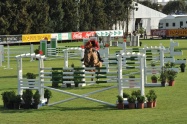 n the tiebreaker of this contest has to be made on the 6 obstacles that previously had been raised progressively. Once the first tiebreaker is done, some obstacles can start being removing in number until having just 3-4 obstacles in the stage. The ones who have been removed are the lowest ones and the 11 m measure is maintained between those ones who haven’t been removed. It can happen, however, that if there are a lot of tiebreakers, the height of the obstacles in the last round will raised up to more than 1.80 m high.
n the tiebreaker of this contest has to be made on the 6 obstacles that previously had been raised progressively. Once the first tiebreaker is done, some obstacles can start being removing in number until having just 3-4 obstacles in the stage. The ones who have been removed are the lowest ones and the 11 m measure is maintained between those ones who haven’t been removed. It can happen, however, that if there are a lot of tiebreakers, the height of the obstacles in the last round will raised up to more than 1.80 m high.
Here you have an example:
OTHER HORSE COMPETITIONS
**HUNTING OR SPEED AND DRIVEN CONTEST: (CROSS COUNTRY)**
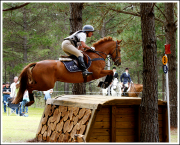 The aim of this event is to see how obedient, tractable and how fast the horse is along one difficult and varied obstacles route. That is way are called speed and driven contest. And the reason of calling hunting contest too, is because the participants have to jump over natural obstacles such as embankments, slopes, ditches…etc like hunters in the past and also nowadays use to do when they go with their horses to hunt.
The aim of this event is to see how obedient, tractable and how fast the horse is along one difficult and varied obstacles route. That is way are called speed and driven contest. And the reason of calling hunting contest too, is because the participants have to jump over natural obstacles such as embankments, slopes, ditches…etc like hunters in the past and also nowadays use to do when they go with their horses to hunt.
In all the routes participants are allowed to jump alternative obstacles that could help them to end the contest in less time but of course these alternative obstacles are more difficult to overcome. Indeed, there is no fixed route to follow but there are some indicators that indicate in which direction has to be the obstacles jumped. In addition, some points in the route can also appear as necessary to be passed in case it is necessary.
Here you have an example:
**DRESSAGE**
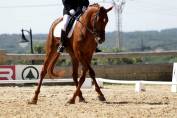 The aim of this competitions is that the horse has to do some concrete exercises (reprise) in the different speeds/airs, which are walk, jog or trot and gallop. It has to do this concentrating on what their rider is saying and ordering it.
The aim of this competitions is that the horse has to do some concrete exercises (reprise) in the different speeds/airs, which are walk, jog or trot and gallop. It has to do this concentrating on what their rider is saying and ordering it.
The judges will give a score from 0 to 10 depending on what both the rider and the horse have done in every concrete exercise. At the end this scores will be discussed among all judges and the participants that better score reached, will be the winners.
This is what judges evaluate:
- The repise
- The speeds/airs(walk, jog or trot and gallop)
- The impulsion
- The submission
- The seating and the position of the rider
The practices: at the beginning judges want to see how the rider balances and moves freely. In this first steps, the “Binomial” just do simple exercises that are based on walk and trot. Afterwards, the difficulty of the practices increases passing through the categories: Fry, Kids, Cadet and Youth. After these categories there are two more categories: the intermediate and the called “Gran Premio”. This last category will be related to international championships, and the Olympic Games.
Here you have some examples:
**RACES**
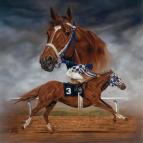 Horse races are based on speed competitions in which the aim is to be the fastest “binomial” or competitor of the race. The race can be between two or more horses and their riders. It is considered one of the most ancient and popular sport as well as one of the most organized and commercialized.
Horse races are based on speed competitions in which the aim is to be the fastest “binomial” or competitor of the race. The race can be between two or more horses and their riders. It is considered one of the most ancient and popular sport as well as one of the most organized and commercialized.
At the beginning this kind of competitions were known as horse-carts races that as the name says consist on horses pulling the carts in which the riders were guiding them. This was very common in Rome.
Nowadays, there are different categories or practices involved the races: flat races, hurdles races, cross country races, trotting races…etc
It is important to say that in horse races there are the owners of the horse, the coacher, the jockey and the horse carer around all the time and when there is a competition all of them go there. In addition, and related to this, the pureblood horses are the kind of horses used for this competition as they are the fastest, the strongest and the most resistant horses for this kind of competitions. However, they are fragile animals against illnesses and need to be very well cared. And that is way the owner, the carer, the coacher and the jockey are pampering and caring the horse so much.
In addition, these competitions require a strong concentration both for the rider and for the horse, but especially for the rider that even it is better and has more possibilities to win a race if they are not too tall. Due to this you will see that most of the jockeys are about 48-50 kg and 1.50 cm high. So the physical conditions are very important and not only the one of the rider but also one of the horses.
Here I leave you one true race about one incredible horse called “secretariat” (Big Red), that is consider the fastest race horse ever existed all around the world in the races of long distance. Still there doesn’t exist a horse who has beat his record. This is the video: http://www.youtube.com/watch?v=2c_ylcxgCaI
MY EXPERIENCE AND OPINION:
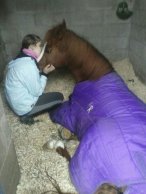 This hobby in general is one of the most completed sports, if we take into account that you train all your body and specially your hands, arms, and legs and at the same time you train also your brain. I mean, this hobby is not individual but dual as are you and your horse that have to jump over obstacles. This means a high level of concentration both for you and the horse. This is very important because horses are wild animals that leave us domesticate them. Due to this the relationship between you and your horse has to be strong and you have to trust one to each other. With this I mean that if you are afraid to jump the horse will know that and in case it is a very brave horse, it is going to refuse to jump. I mean, if the horse feels that you are not able to overcome the obstacle it will start feeling the same and both will become unable to jump. So to jump both you and your horse have to be ready to do it and in case you feel your horse is not sure to jump you have to give it the confidence to do it. It looks complicated but it is just making connections with your partner which in this case is your horse and instead of being two members appeared jus as one.
This hobby in general is one of the most completed sports, if we take into account that you train all your body and specially your hands, arms, and legs and at the same time you train also your brain. I mean, this hobby is not individual but dual as are you and your horse that have to jump over obstacles. This means a high level of concentration both for you and the horse. This is very important because horses are wild animals that leave us domesticate them. Due to this the relationship between you and your horse has to be strong and you have to trust one to each other. With this I mean that if you are afraid to jump the horse will know that and in case it is a very brave horse, it is going to refuse to jump. I mean, if the horse feels that you are not able to overcome the obstacle it will start feeling the same and both will become unable to jump. So to jump both you and your horse have to be ready to do it and in case you feel your horse is not sure to jump you have to give it the confidence to do it. It looks complicated but it is just making connections with your partner which in this case is your horse and instead of being two members appeared jus as one.
After saying all this I think that, however, sometimes I think that when talking about top competitions it is not just the confidence and the connection to the horse that works, but the abuse and the force made to the horse to jump. Of course this is not in all the cases but some people in this kind of competitions as the awards are huge quantities of money horse sometimes are taken to their limit. I am completely against this kind of abuses but In favor of practicing this sport or hobby in not an abusing way.
ABSTRACT:
As you can see this BlogSpot is about the horse show jumping competitions. First of all there you have an introduction to see what points are going to be developed and then all those points appeared starting with the origin of the horses for you to see a little bit what has been the process of those beautiful and powerful animals; then, Horse and rider equipment; what is this discipline in general based on; when, how and why does this discipline developed until nowadays; the rules of the competition; type of obstacles; ponies competitions and the most important events of the show jumping competitions of horses, which are: progressive difficulty event, the derby event, Doubles and triples event, Dexterity and power contest or event, Potency events, and The sixbars´ dexterity contest. Finally, there appeared information about the other 3 competitions, which are Hunting or speed and driven contest: (Cross Country); dressage and race. And to conclude you can find my own experience and what is my opinion about this competitions.
REFERENCES:
- Hirst K. Kris, Horse History Domestication and History of Equus caballus. Available at: http://archaeology.about.com/od/domestications/qt/horses.htm [Accessed December 9, 2012].
- Warmuth Vera, El origen de los primeros caballos domesticos. Available at: http://www.abc.es/20120507/ciencia/abci-origen-primeros-caballos-domesticos-201205071844.html [Accessed December 8, 2012].
- Wikipedia, Salto alto. Available at: http://es.wikipedia.org/wiki/Salto_alto [Accessed December 8, 2012a].
- Wikipedia, Salto ecuestre. Available at: http://es.wikipedia.org/wiki/Salto_ecuestre [Accessed December 8, 2012b].
- Wikipedia, Salto largo. Available at: http://es.wikipedia.org/wiki/Salto_largo [Accessed December 8, 2012c].
- agrobit, Historia del Caballo . Available at: http://www.agrobit.com/Info_tecnica/Ganaderia/Prodequi/GA000002pd.htm [Accessed December 8, 2012].
- caballosweb, Origen del Caballo . Available at: http://www.caballosweb.com/elcaballo/origen.html [Accessed December 8, 2012].
- j.c alba, El Caballo. Available at: http://www.monografias.com/trabajos/elcaballo/elcaballo.shtml [Accessed December 8, 2012].
- A. Guisepi, R., The Stone Age. Available at: http://history-world.org/stone_age.htm [Accessed December 9, 2012].
- Wikipedia, Arabian horse. Available at: http://en.wikipedia.org/wiki/Arabian_horse [Accessed December 9, 2012a].
- Wikipedia, Dressage. Available at: http://en.wikipedia.org/wiki/Dressage [Accessed December 9, 2012b].
- Wikipedia, Federico Caprilli. Available at: http://en.wikipedia.org/wiki/Federico_Caprilli [Accessed December 9, 2012c].
- Wikipedia, Horse racing. Available at: http://en.wikipedia.org/wiki/Horse_racing [Accessed December 9, 2012d].
- Wikipedia, Markus Fuchs (equestrian). Available at: http://en.wikipedia.org/wiki/Markus_Fuchs_(equestrian) [Accessed December 9, 2012e].
- Wikipedia, Pegasus. Available at: http://en.wikipedia.org/wiki/Pegasus [Accessed December 9, 2012f].
- Wikipedia, Trojan Horse. Available at: http://en.wikipedia.org/wiki/Trojan_Horse [Accessed December 9, 2012g].
- Bloogs Network SL, Ponies, caballos en miniatura. Available at: http://animalmascota.com/ponies-caballos-en-miniatura/ [Accessed December 11, 2012].
- Cerdido Gastesi, A., ALTURAS Y DISTANCIAS QUE SE UTILIZAN EN LAS PRUEBAS DE SALTO PARA PONIS_. Available at: http://www.angelcerdido.es/distancias-pony.html [Accessed December 11, 2012].
- Federacion Hipica Española, Galopes. Available at: http://www.rfhe.com/galopes-homologaciones-y-t%C3%A9cnicos-deportivos/galopes.aspx [Accessed December 11, 2012a].
- Federacion Hipica Española, Reprises. Available at: http://www.rfhe.com/doma-cl%C3%A1sica/reprises.aspx [Accessed December 11, 2012b].
- Galeon.com, Raid. Available at: http://www.galeon.com/cabrera2/raid.htm [Accessed December 11, 2012].
- Wikipedia, Carreras de caballos. Available at: http://es.wikipedia.org/wiki/Carreras_de_caballos [Accessed December 11, 2012a].
- Wikipedia, Doma clásica. Available at: http://es.wikipedia.org/wiki/Doma_cl%C3%A1sica [Accessed December 11, 2012b].
- Wikipedia, Polo. Available at: http://en.wikipedia.org/wiki/Polo [Accessed December 11, 2012c].
- EnergizeInfo, YOUTUBE: Beezie Madden and Judgement, Nexen Grand Prix . Available at: http://www.youtube.com/watch?v=W5OJ8xHesAM [Accessed December 11, 2012].
- TBsPlease, YOUTUBE: Puissance WIHS – Horse jumps 7 foot wall! Available at: http://www.youtube.com/watch?v=yRFPlaN1JvA [Accessed December 11, 2012].
- Taringa, Secretariat!!- La Biografia Del Mejor Caballo Del Mundo! Available at: http://www.taringa.net/posts/noticias/10148576/Secretariat_–La-Biografia-Del-Mejor-Caballo-Del-Mundo_.html [Accessed December 12, 2012].
- WarwickRex, YOUTUBE: Michael Whitaker – Animation II – Derby Qual. 2, Hamburg 2011 . Available at: http://www.youtube.com/watch?v=89EVSaxk118 [Accessed December 11, 2012].
- Wikipedia, Secretariat (horse). Available at: http://en.wikipedia.org/wiki/Secretariat_(horse) [Accessed December 12, 2012].
- azzeep, YOUTUBE: Seis Barras CSI*** San Sebastian – Infoecuestre.com . Available at: http://www.youtube.com/watch?v=3APdx-eCm74 [Accessed December 11, 2012].
- buzzterbrown, YOUTUBE: The Cross Country Ride to London – 2012 Olympic Preview . Available at: http://www.youtube.com/watch?v=Q8aShtqmJ_o [Accessed December 11, 2012].
- dano2607, YOUTUBE: ANKY VAN GRUNSVEN – WEG2006 Freestyle Final. Available at: http://www.youtube.com/watch?v=MPJGEzI3aIc [Accessed December 11, 2012].
- ollieweddingfu, YOUTUBE: Secretariat Triple Crown Winner: Belmont Stakes . Available at: http://www.youtube.com/watch?v=2c_ylcxgCaI [Accessed December 12, 2012].
- philpheburbs, YOUTUBE: Hip Hop Dressage . Available at: http://www.youtube.com/watch?v=knCj92zA0tU [Accessed December 11, 2012].
- sainglain, YOUTUBE: Michael Whitaker & Owen Gregory – Hickstead Derby 1986 . Available at: http://www.youtube.com/watch?v=8qGQnmnKIGU [Accessed December 11, 2012].
Filed under: Uncategorized Tagged: Sports
![]()
